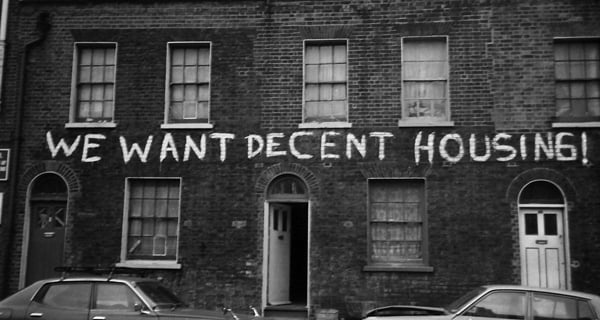In this latest blog from the Procure Partnerships Framework, Framework Director Robbie Blackhurst gives his view on five steps that with help to solve the UKs current Social Housing Crisis.
Solving the Social Housing Crisis
The UK is currently in the middle of a social housing crisis and is desperately lacking affordable, high quality social housing options. Over the last 40 years there has been a catastrophic decline in the construction of new social housing, leaving millions of people currently living in unaffordable privately rented homes. There are currently over 1.2 million households who are on the social housing waiting list.
This lack of affordable social housing and the reliance on more expensive private rentals to bridge the gap, is tipping more and more people into homelessness. In fact, housing and homelessness charity Shelter, reported that in the last five years the number of homeless families living in temporary accommodation has increased by 48%, with the loss of a private tenancy cited as being the single biggest cause of homelessness in 2018.
But what can be done to solve this crisis in these challenging political and economic times? In this blog Robbie Blackhurst, Procure Partnerships Director, looks at why the social housing sector has found itself in crisis and how the construction industry can play a part in the solution.
Why is social housing important in the UK?
Social housing provides an affordable and long-term housing solution for those on low incomes. Tenants benefit from tightly controlled rents which reflect the average local income. Residents are provided with long-term tenancies, allowing them to avoid the six- or twelve-month contracts common in private rentals. This provides families with stability and gives them the opportunity to put down roots.
The chronic shortage of social housing means it is currently severely rationed and tenants are forced into expensive private rentals. The private rental sector is also bursting at the seams and tenants often feel obliged to put up with unfit and unhealthy living conditions through fear of potential eviction.
What has caused the current social housing crisis?
From the Second World War up to 1980, the UK saw the construction of an average of 126,000 social homes every year. In the last 40 years there has been a significant drop in numbers, and in 2017/18, just 6,463 new social homes were built.
New Build Annual Social Housebuilding Completions since 1945 (Shelter)
This dramatic slowdown in the delivery of new social housing is at the heart of the UK’s current housing emergency. But alongside the reduction in new build housing, there are other issues which have also had a significant impact on the current housing situation.
The UK is only a relatively small island and the opportunity for new housing developments are restricted by the amount of available land. There is a controversial trend for property investors to hold on to land that could be used for housing until it reaches the peak of its value. This perfectly legal, but frustrating practice prevents affordable housing developments from going ahead as the cost of the land is already incredibly high. Investors, particularly in city centres, still hold the majority of control over new developments, with many developments aimed solely at investor purchase rather than as affordable homes for first time buyers.
What needs to be done to ensure more social housing developments?
1. More Investment!
The National Housing Federation has stated that England needs 340,000 new homes, including 145,000 affordable homes, until 2031, to meet current demand. This includes 90,000 for social rent and 25,000 for shared ownership.
The single, biggest factor to influence how many social houses are built is large scale, long term government investment in social rent. The National Housing Federations has stated that housing associations need to work in partnership with other housing associations, local authorities and with the private sector to access the skills, funding or relationships that are required to make this vision a reality.
2. Promote land reform
Land is extremely expensive, especially in the places where new homes are most needed. Shelter has reported that the total value of residential land in the UK has risen by 583% between 1995 and 2017, making land costs the biggest barrier to more new build affordable houses.
In the immediate Post-war period, social housing providers benefitted from legislation which enabled them to access land at affordable prices. The Land Compensation Act 1961 significantly changed this and has meant that, in cases of compulsory purchase, the price of land is based on the most profitable use imaginable. Land reform which works to reduce the cost of land would make more social housing developments an affordable and viable option.
3. Utilise alternative methods of construction
Even with the necessary funding in place and the required quantity of affordable land available, there would still be many challenges that the UK construction industry would need to tackle in order to deliver the quantities of housing required.
Moving away from traditional construction methods and materials and considering alternative ways to build houses is essential to speed up the building process and provide a more cost-effective solution. Whilst traditional building methods currently form the dominant part of the UK’s house building strategy, they are incapable of delivering the volumes of housing needed long term.
In the 2018 RICS report, ‘Modern Methods of Construction – A forward – thinking solution to the housing crisis’ it states that it would be impossible to source all the bricks required to build the number of homes targeted by the government. Many contractors do not have enough materials to even meet the current levels required, with some having to wait months for supplies. The UK relies heavily on materials imported from Europe and beyond, and so there is the potential that this situation will only be exasperated further as we navigate through the unknowns of the Brexit process.
Utilising new and emerging technologies and materials may be the answer. The UK needs to look to other countries who have successfully addressed similar housing issues, and embrace materials such as Cross Laminated Timber which can be used to form environmentally sustainable walls, roofs and floors. Modern Methods of Construction (MMC) can provide the opportunity to streamline the construction process via off-site fabrication and modular installation, significantly reducing the construction period whilst increasing overall build quality.
4. Encourage new talent and upskill the workforce
In his 2016 report, ‘Modernise or Die’, Mark Farmer identified a skills crisis in mainstream construction which may result in a 20-25% decrease in the construction workforce over the next decade. This shortage of skilled workers is also likely to be exacerbated by Brexit; currently one in eight UK construction workers are foreign, which rises to around one in four in London.
It is widely acknowledged that there is an urgent need to encourage more workers into the industry and to promote construction as a viable and exciting career option for young people. If the skills shortage is not addressed, a lack of skilled workers will greatly hinder the UK’s ability to build the levels of social housing required. It is important that more apprenticeships and training programmes are developed which support the rollout of Modern Methods of Construction and digital technologies, with the aim of encouraging new talent into the industry.
Alongside recruiting new talent, the industry also needs to focus on upskilling the existing workforce to ensure they have the modern skills necessary to drive the industry forward. It is the responsibility of the entire industry to utilise whatever public or private funding is available to upskill their workforce in order to actively embrace new technologies.
5. Utilise innovative solutions and designs from outside of the UK
When planning future housing developments, we need to avoid falling into the trap of replicating what has been done before when there is so much room for improvement. Historically, the UK has built houses which have a reputation for being expensive, yet poor-quality and not always practical for family life. Many occupants struggle with ongoing defects and project costs and timescales can be unpredictable. In 2017 a survey conducted by Shelter found that 51% of new build homeowners had experienced major problems with their properties, including issues with construction, unfinished fittings and faults with utilities.
Efforts to improve affordable housing should be informed by innovative solutions from a broad range of solutions outside of the UK. A departure from conventional ideas around size, design and materials will open up the sector to other intelligent options. This could include the conversion of existing unused buildings, the promotion of community-led initiatives which give control back to local people, the development of innovative and unconventional designs which can address local health or social issues, or even the use of converted shipping containers as a low cost solution!
Whilst there is no quick fix available to address the current housing crisis, it is clear that the industry needs to look outwardly in order to find new and innovative solutions to help build happy, healthy and sustainable communities.

Robbie Blackhurst is the Founder and Director of Black Capital Group, the holding company that powers Advance Social Value, Compliance Chain, Procure Partnerships Framework and Strategic Resourcing. Robbie is a member of the Chartered Institute of Builders, is MCIPS certified and has an undergraduate degree in Aviation and Aerospace, a postgraduate degree in Construction Project Management, and a Master’s in Business (MBA).


